Ambroz Valley - Winner 2019
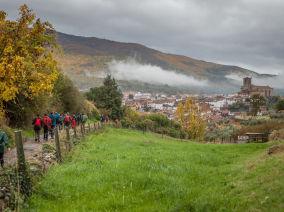
Winner in the ‘Health and wellbeing tourism’ category
The Ambroz Valley (Valle del Ambroz) is a small rural area located in the north of Extremadura Region, one of the most rural regions in Europe. Ambroz Valley is one of best places to enjoy life and nature. Envelop yourself in its untouched nature, clear air, breathtaking landscapes, healing thermal waters from Roman times, delightful restaurants, or charming accommodations. The Ambroz Valley offers all of this while working for sustainable tourism, under the ‘liveable biodiversity’ label.
What makes Ambroz Valley special
A hidden treasure among the high mountains in the heart of Iberian Peninsula, in between Madrid and Lisbon. Full of history and plenty of gorgeous vegetation, old giant trees, and millenary routes for biking or hiking like Celts or Romans along the Vía de la Plata – West Saint Jacques route. Relax in modern baths and health resorts with a tradition going back over 2,000 years.
Authentic people, tasty and nature food with traditional dishes at one of the many restaurants in the area, and charming lodging in traditional and historical buildings. Ambroz Valley has all you need for your comfort and relaxation.
Health and wellbeing tourism
Ambroz Valley is composed by 8 municipalities, mainly characterised by agriculture and farming. The destination employs sustainable management of precious natural and cultural resources, shown by its mineral waters and Thermal Heritage. This in combination with the landscape and nature-based activities makes Ambroz Valley a quality destination for health and well-being.
Ambroz Valley aims to preserve the natural and cultural heritage. Here, tourism goes hand in hand with raising awareness and strategies to protect resources in line with the natural and cultural values of the territory. Since 1997, Ambroz Valley has collaboratively been working on sustainability with local people and organisations through a non-profit association. Because of this, Ambroz Valley today offers a holiday offer based in the richness of local resources and values, while saving energy, fighting against light pollution and improving water and waste management.
The peace and tranquility of the land have been a defining feature for ages, attracting many visitors and settlers. Segura de Toro’s Templar castle and Hervás Jewish quarter are excellent examples from the Middle Ages. There are archaeological ruins of the Renaissance palace of Sotofermoso (Duke of Alba’s summerhouse) in Abadía, which was frequented by well-known authors such as Lope de Vega and it is also where they wrote their recognized works. Today, the health and wellbeing elements are exemplified by the thermal waters (with 3 spas), natural pools and snow in La Garganta névé or La Covatilla skiing area.
Sightseeing tips
- Visit Baños de Montemayor Roman Spa, a cultural and health thermal experience with a tradition of more than 2,000 years. Delve into its history and take a bath in the thermal swimming pools set beside the ancient Roman thermal baths.
- Cycle the Silver Route and discover Ambroz Valley’s beautiful landscape. The Greenway is reserved for non-motorized journeys and its layout coincides with the disused railway line and the Camino Mozárabe de Santiago.
- Celebrate with locals and experience the Otoño Mágico (Magical Autumn) nature event that includes trekking, music, theatre and gastronomy, among many other activities.
- See extraordinary mountain landscapes barely 20km from the meadow of Extremadura. Its overgrown woodlands, meadows and orchards full of cherry and plum trees are a true breathtaking show.
More information
- The official Ambroz Valley website
- EDEN video about Ambroz Valley - Winner 2019
- EDEN contact for Ambroz Valley: valleambroz
 gmail [dot] com
gmail [dot] com
Land of Saint Ignatius - Winner 2017
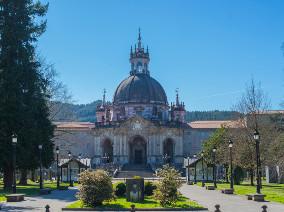
Winner in the Cultural Tourism category
The regions of Urola Erdia, Urola Garaia, and Debagoiena, in the Province of Gipuzkoa (Spain), form the so-called Land of Saint Ignatius of Loyola. This is where he was born, had his conversion and became a pilgrim. Discover the universal figure of St. Ignatius linked to his homeland and to the period in which he lived, the 16th century. Step by step, following routes crafted for this project and visiting several scenes. Land of Saint Ignatius provides a rich artistic and architectural legacy, both civil and religious (located in the towns part of the Region). Trace the economy and lifestyle of the 16th century reflected in several museums and the Ignatian Way surrounded by a stunning landscape.
What makes Land of Saint Ignatius, Basque Region special?
The Land of Saint Ignatius of Loyola comprises a rich historic, artistic and architectural heritage, all organised around a universal figure and his period, in a stunning landscape. You can visit the impressive Loyola Sanctuary, a beautiful work of art in a hidden chapel. Then, go for a walk through the Ignatian Way enjoying the landscape and breathing fresh natural air, all in the same day.
Cultural tourism
This journey is mainly made up of paths and villages off the beaten track close to locations like Loyola, San Sebastian or Bilbao. This is a sustainable experience focused on locals to preserve the authentic sense of the region's culture.
This destination is managed by 3 public tourism boards, and the stakeholders are the local authorities. The stakeholders' working criteria is based on sustainability, social cultural and natural.
The Land of St. Ignatius is centred around his birthplace, where the medieval Tower House where he was born remains. The Loyola Sanctuary was built around it in his honour between the 17th and 19th centuries. It is a spectacular Italian style building, with a circular basilica presiding all.
Thousands of pilgrims and tourists from all over the world come to visit Loyola every year. The few of them that get to know the related cultural treasures other than the Sanctuary go back home touched by the enigmatic things they have seen and experienced. The Land of Saint Ignatius aims to increase these rare occasions.
Sightseeing tips
- La Antigua Hermitage - The impressive hermitage known as the cathedral of Basque hermitages built in stone and wood has an incomparable beautiful interior
- Sanctuary of Loyola - Grand monumental baroque style complex built around the birthplace of St. Ignatius
- Arantzazu Sanctuary - The Sanctuary of Arantzazu, built in stunning natural surroundings has become a symbol of spirituality and Basque culture
More information
- Land of Saint Ignatius (in English)
- EDEN video about Land of Saint Ignatius - Winner 2017
- EDEN contact for Land of Saint Ignatius: i-loiola
 urolaturismo [dot] eus (i-loiola[at]urolaturismo[dot]eus)
urolaturismo [dot] eus (i-loiola[at]urolaturismo[dot]eus)
Goierri, Basque Country - Winner 2015
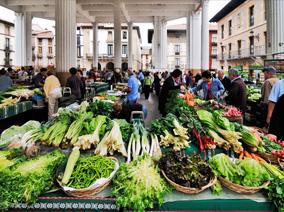
Winner in the Tourism and Local Gastronomy category
The district of Goierri is a perfect example of the authentic Basque countryside. It is a special place where 5 local features come together to make Goierri a top destination for travellers:
- Good food: It is the cradle of products of international renown such as Idiazabal cheese.
- Nature: Tradition, quality and peaceful atmosphere. Admire the beauty of its natural parks and taste the traditional cuisine that uses only fresh, seasonal quality produce.
- Local products: Experience the pleasure of buying local products at one of the most important fresh market in the Basque Country, the Ordizia market.
- Culture: Immerse yourself in surprising ancient traditions and feel completely at home at the same time. Enjoy the peace and quite you have always dreamed of in its numerous high-quality hotels and restaurants.
- The green carpet: you are cordially invited to come into the Basque home, which is open to everyone.
Goierri was settled in ancient times, and grew to be a major commercial enclave in medieval Spain with Jewish quarters and markets dating from about 1200. The region is nestled between two natural parks, crossed by the Camino Real and Camino de Santiago (Way of Saint James). It is one of the regions of the Basque Country where Basque is spoken the most.
Througout the year, visitors can attend over 30 food fairs and other cultural events like medieval fairs, Holy Week processions and festivals. Goierri is host for the The Basque Country Great Cheese Championship.
Local gastronomy
The Goierri is the first 'culinary tourism club' of the Basque Country, meaning that all the local stakeholders involved one way or another with the local gastronomy work together to develop strategist that position the Goierri as one of the most important gastronomy destinations of the Basque Country.
This club consists of dairy, cheese and cider farms, bakeries, restaurants, rural accommodations, gourmet and delicacy shops, tourism guides, etc.
Goierri is the top destination for local cuisine of the Basque Country, thanks to local products such as cheese, cider and Txakoli, and the skill of its chefs, who buy the fresh produce they use for their traditional and modern cuisine at the famous Ordizia market and from local producers.
Goierri is deeply involved in sustainable initiatives and collaborate with the Agency for Rural Development of the region. For over 15 years Goierri, originally an industrial area, has been investing in a susatainable and authentic tourism model.
Goierri is a destination not overcrowded, with its own unique identity, and differs dramatically from the archetypical 'sun and beach' tourism so popular in other parts of Spain.
Sightseeing tips
- Visit the Ordizia market. Take a guided tour with chef Xabier Martinez and find the best seasonal products and producers that come to the market every Wednesday. The Ordizia market har taken place here since 1512, showcasing the best produce that the region has to offer.
- Go to the Idiazabal territory to taste authentic Basque food. Enjoy a guided tour in the Ondarrre cheese factory, in the town of Segura. Here, the shepherds have spend decades producing the artisanal Idiazabal cheese. Visit the stables, parlour and rooms, and round off the experience with a delicious cheese tasting, accompanied by wine or the local Txakoli.
- Become a basque shepherd for a few hours in one of the two natural parks: Aralar and Aizkorri-Aratz. Share unforgettable moments with a local shepherd who will explain everything you want to know about the Idiazabal cheese. In the warmer months, the shepherd remains on the mountain with the sheep, and might give you a demonstration of how his sheepdog guards the sheep in the pasture.
More information
- The official website of Goierri
- EDEN video about Goierri
- EDEN contact for Goierri: goierri
 goierriturismo [dot] com (goierri[at]goierriturismo[dot]com)
goierriturismo [dot] com (goierri[at]goierriturismo[dot]com)
Natural Park of Guara's Mountains and Canyons - Winner 2013
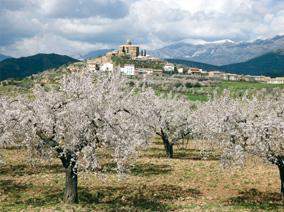
Winner in the Accessible Tourism category
With more than 80,000 ha. under protection, the Natural Park Sierra y Cañones de Guara is one of the most iconic natural sites in the Aragonese Natural Network.
Apart from its nature, culture and landscape, the park also offers a large variety of recreational activities, such as rambling, canoeing, climbing, bird-watching, mountain biking and numerous cultural visits.
The Guara Natural Park is a destination where tourism is closely related to adventure and nature sports.
Accessibility
Since 2006, the Natural Park Sierra y Cañones de Guara is promoting accessible tourism or 'Tourism for all'. This project involves all local and regional public authorities, along with organisations representing persons with disabilities and business.
Currently, infrastructures adapted for people with different disabilities include tracks in nature, rambling, a variety of mountain sports, bird-watching, exploring the cultural heritage (Alquézar, Lecina, etc.) and tasting the local cuisine... all in the Natural Park.
Sightseeing tips
- Enjoy the bird-watching in Vero River Canyon
- Walk, touch and breathe Guara along the accessible pathway of Tamara
- Discover the ancestral customs on the Pathway of the Millennium Oak.
More information
- The official website of The Natural Park of Guara's Mountains and Canyons
- Watch the EDEN video about The Natural Park:
- Long version (3 minutes)
- Short version (1 minute)
- EDEN contact for the Natural Park of Guara's Mountains and Canyons: comena
 aragon [dot] es (comena[at]aragon[dot]es)
aragon [dot] es (comena[at]aragon[dot]es)
Trasmiera Ecopark - Winner 2011
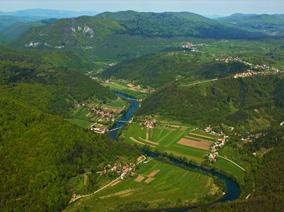
Winner in the Tourism and Regeneration of Physical Sites category
Trasmiera Ecopark is a cultural and environmental project in the Cantabria region, on the northern coast of Spain. The park, overlooked by lush forests and hills, and showcases the areas great natural environment, cultural heritage and history.
The park was launched by the local municipality of Arnuero, to enhance the countys appeal as a holiday destination, while at the same time conserving the remarkable natural environment.
Regeneration and revival
The Trasmiera Ecopark initiative began in 1998, aiming to maintain the historical identity of the region and restore its cultural heritage.
Several landmarks were regenerated and given a new purpose. For example, the Santolaja old tide mill was turned into an 'Observatorio de las mareas' or 'Observatory of tides' – an information center, educating visitors on coastal tides and its role in shaping the region.
An old school was turned into an 'Observatorio del arte' (Art Observatory), which serves as an exhibition centre for local and international artists. World-famous artists, such as Cristobal Toral, Javier Perez, Jose Luis Sanchez, Gloria Torner and Roberto Orallo have all had exhibitions here.
Sightseeing tips
- Visit the Iglesia de la Asuncion. previously a church, this impressive venue has now been converted into exhibition center for local artists.
- Visit the incredible Santa Olaja tide mill, which still uses the force of the tides to grind wheat.
- Visit the Cabrahigo Tower – a 15th century tower which represents an impressive example of gothic architecture.
- Visit the stunning beaches and soak up the sunshine.
More information
- The official website of Trasmiera Ecopark
- Watch the EDEN video about the Ecopark:
- Long version (3 minutes)
- Short version (1 minute)
- EDEN contact for The Trasmiera Ecopark: ramonmeneses
 terra [dot] es (ramonmeneses[at]terra[dot]es)
terra [dot] es (ramonmeneses[at]terra[dot]es)
A Guarda - Winner 2010
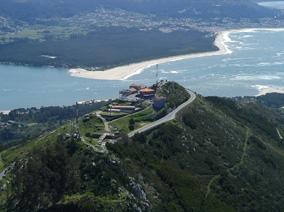
Winner in the Aquatic Tourism catgory
A Guarda is a traditional fishing village on the western coast of Spain, bordering to Portugal in the south. Flanked by the Miño river and the mountain of Santa Trega, A Guarda is known as the 'Lobster Capital', because of its quality seafood and beautiful coastal beaches and landscapes.
From the summit of Mountain Santa Trega it is possible to view the mouth of river Miño that flows into the Atlantic Ocean, the bordering lands of Portugal on the other side of the river, and even the beautiful valley formed by two mountain ranges: Argallos and Groba.
What makes A Guarda special?
The estuary at the mouth of the Miño river is a wide humid area of 1,668 ha of high ecological value. It is known as the 'Galician Doñana' by biologists and ornithilologist alike, due to the variety and quantity of birds lodging during the winter season.
In 2010, new trekking routes were established along the coast and the riverside, offering pleasurable and more challenging walks for trekking enthusiasts.
Don't miss
- the Castro de Santa Trega, which is the most important sample of ancient settlement in all the Northwestern Iberian peninsula
- the historic center where you can discover 16th century buildings like the Tower of the Reló or the Church of Santa Maria.
More information
- The official website of A Guarda
- Watch the EDEN video about A Guarda:
- Long version (3 minutes)
- Short version (1 minute)
- EDEN contact for A Guarda: turismo
 aguarda [dot] es (turismo[at]aguarda[dot]es) or alcaldia
aguarda [dot] es (turismo[at]aguarda[dot]es) or alcaldia aguarda [dot] es (alcaldia[at]aguarda[dot]es)
aguarda [dot] es (alcaldia[at]aguarda[dot]es)
The Ebro Delta - Winner 2009
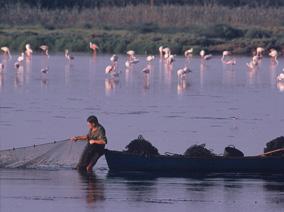
Winner in the Tourism and Protected Areas category
The Ebro river is the second longest river on the Iberian peninsula, running out on the eastern coast of Spain, south of Barcelona and north of Valencia.
The Ebro Delta Nature Park consists of calm lagunes and breath-taking landscapes, making it an ideal destination for stepping out of the hustle and bustle of city life into the tranquility of nature.
The region boasts a number of majestic viewpoints and walking trails, and is perfect for wildlife and bird-watching. The Punta de la Banya (The Gem of the Park) is the Delta's largest natural area and one of the Mediterranean's most important waterfowl breeding areas.
What makes the Ebro Delta special?
The natural diversity in the area is unparalleled, and the delta is considered one of the most exotic places in all of Spain.
Surrounded by the park's lagoons is La Punta del Fangar, a desert-like area with vast sand landscapes and dune formations. View points offer sweeping views of the Bay of Fangar, where mirages can be seen on certain days.
The Ebro Delta houses some of Spain's most time-honoured human use of land, including fishery, livestock farming and rice growing. For centuries people living here have worked the land while also caring for the region.
As in the case of most places of splendour, beauty draws crowds. In 2006, the Ebro Delta adopted the European Charter for Sustainable Tourism, to protect the park's natural heritage.
Public and private investments are made to ensure that the area monitors the adverse impact of tourism on the landscapes. A commitment has also been made to protect the park from excessive tourism development.
The main objective is to keep the Ebro Delta as pure as possible.
What to look for in...
- Spring: Flooded rice paddies turn the delta into a dream world.
- Summer: Rice grains take on warm, golden hues as they await the harvest.
- Fall: Flocks of migratory, aquatic birds descend on the delta.
- Winter: Undulating sand dunes are the perfect backdrop for stunning sunsets.
Hightlights of the Ebro Delta Nature Park
- Listening to the wind whistle through the rice paddies
- Tasting freshly caught bass and carp
- Sightings of rare and unusual birds depending on the season
- Sinking your feet in the warm, fine sand of La Punta del Fangar
More information
- The official website of The Ebro Delta Nature Park
- Watch the EDEN video about The Ecopark:
- Long version (3 minutes)
- Short version (1) minute
- EDEN contact for the Ebro Delta Nature Park: marco [dot] ijuanf
 gencat [dot] cat (marco[dot]ijuanf[at]gencat[dot]cat)
gencat [dot] cat (marco[dot]ijuanf[at]gencat[dot]cat)
The Sierra de las Nieves - Winner 2008
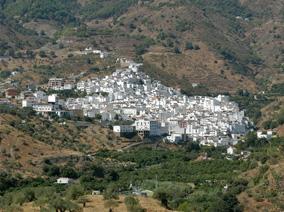
Winner in the Tourism and Local Intangible Heritage category
Sierra de las Nieves is a mountain range in the central part of the Málaga province in the south of Spain.
The district borders Costa del Sol, the Guadalhorce River Valley (Valle del Guadalhorce), the Ronda Hills (Serranía de Ronda) and the district of Guadalteba, making it a strategic location well served by public transport.
In this rural and hilly district people still live in perfect balance with nature. The nine main towns of the Sierra are connected by the whimsical twists and turns of the mountain roads, and still retain the rich tapestry of styles and cultures that are typical for the area.
In the heart of the district lies the Parque Natural (Nature Park) home to one of the world’s biggest Spanish fir woods, spanning over 3,000 ha. The park has no paved roads, and is a watershed area between Atlantic and Mediterranean landscape and climate.
The district also has the world’s biggest peridodite massif, a gigantic primary-era batholith rock with serpentine outcrops. This leads to the mineral richness of the spa water in thermal baths.
The Sierra de las Nieves is a place for adventurous leisure pursuits such as horse riding, canyoning, canoeing and kayaking, eco-routes in off-road vehicles, balloon trips, trekking and hiking.
It is listed by UNESCO as a biosphere reserve.
Ethnography - the star attraction
Tourism in Sierra de las Nieves is a highly organised affair. Sustainable tourism is at the core of the tourism strategy in Sierra de las Nieves, and aims to preserve natural and cultural heritage and enhance quality of life.
Ethnography is above all the star tourism product, uniting the whole district. Its core is the Ethnographic Encyclopaedia of the Sierra de las Nieves, which compiles local folk wisdom.
Elderly people who act as tour guides keep the local history alive, and play the role of ambassadors of cultural identity. Cultural mediators are also tasked with the responsibility of ensuring the quality of stays in each town.
Sightseeing tips
Crafts and products may be discovered through thematic tours such as the local crop routes – the table olive harvest or the chestnut routes, the lime-gatherer or Calero route – one of the honoured crafts still living, and the pottery route starting at El Burgo’s pottery workshop.
A variety of events, festivals and religious processions are also ways to discover local specificities:
- the Festival de La Luna Mora in Guaro, which has roots in medieval souks, shows traditional Andalusian arts and practices and their Christian, Muslim and Sephardic Jewish influences
- the Festival Folclórico de Tolox with traditional song and dance
- the Castillo del Cante flamenco festival in Ojén
- the Mercado de Carboneros y Oficios Antiguos – Market of Charcoal Burners and Ancient Crafts – in Monda.
More information
- The official website of the Sierra de las Nieves
- Watch the EDEN video about the Sierra:
- Long version (3 minutes)
- Short version (1) minute
- EDEN contact for the Sierra de las Nieves: juanfransisco
 sierranieves [dot] com (juanfransisco[at]sierranieves[dot]com)
sierranieves [dot] com (juanfransisco[at]sierranieves[dot]com)
